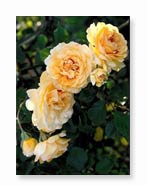Species Roses - Species roses are generally defined as those roses
found in nature. Most species roses tend to be very vigorous and are extremely
disease resistant. They are a good choice for naturalizing and will often grow
well without attention if planted properly and given minimal care during the first
year or so of their establishment. Although many are climbers, with a minimum
of pruning and training they can be grown as hefty shrubs.
Cherokee
Swamp Rose
Mermaid
Yellow Lady Banks
China Roses - One of the East's greatest revealed secret secured by
western civilization was neither gunpowder nor printing but the everblooming rose.
These new roses brought with them two characteristics heretofore unknown to the
west: yellow flowers and remontancy. One of the best pink forms of R. chinensis
to pass into European hands after 1752 was know by many names including Old Blush
or Parson's Pink China. Until the introduction of China roses, the Europeans knew
just one species with some bloom in the fall. The rest of their roses were spring
bloomers. Understandably, they were quite excited when the reblooming trait of
these roses was bred into many of its descendants which include Bourbons, Noisettes
and Polyanthas.
China roses can become large bushes at maturity and are likely to live a very
long time. They are used as hedges, specimen plants and in borders. Chinas can
tolerate heat that makes them well suited for growing in the South.
Old Blush
Archduke Charles
Cramoisi Superieur
Martha Gonzales
Mutabilis
Noisette Roses - The first truly American class of roses originating
in the United States, the Noisettes comprise a group of graceful repeat-flowering
shrubs and climbers. The older varieties with their small flowers and the later,
larger flowered Noisettes (with much Tea influence) are all elegant, highly fragrant
roses. They have the ability to create a landscape effect unique among roses when
trained on walls, fences, arbors or even trees. Immensely popular and well adapted
in the South, Noisettes are truly the "Aristocrats of the Old South."
Lamarque
Madame Alfred Carriere
Crepuscule
Bourbon Roses - The Bourbon rose class resulted from a natural cross
between 'Old Blush' and 'Autumn Damask,' both planted as hedges on the French
island of Bourbon, now known as Reunion. Bourbons have an old-fashioned cupped
or quartered bloom, generally in pastel pinks with tough, blue-green foliage on
a husky bush. These low to medium size shrubs bear blooms of intense fragrance.
Because of their China bloodline, Bourbons succeed wonderfully in the South, being
heat and drought tolerant. However, due to their Damask blood, they are also very
cold tolerant.
Madame Isaac Pereire
Souvenir de la Malmaison
Zephirine Drouhin
Tea Roses - The tea roses are so named because the original teas had
a strong green tea-like fragrance. Teas have an upright habit, forming tall and
sometimes narrow bushes with bronzy red new foliage. In the south, they bloom
profusely in spring and fall with scattered summer flowers. Blossoms are spectacular
and large in pastel shades of pink and yellow with some reds and whites. Fragrance
is distinctive and cool.
Mrs. B.R. Cant
Madame Antoine Mari
Duchess de Brabant
Mrs. Dudley Cross
Monsieur Tillier
Sombreuil
Hybrid Perpetual Roses - Some of the most valuable, historic and delightful
roses are included in the Hybrid Perpetual class. Their virtues include cold hardiness,
outstanding rose fragrance, and large, full flowers. Despite their name, many
varieties only bloom in the spring. They are great cut flowers and this class
is the precursor to the Hybrid Tea class.
Marchessa Boccella
Baronne Prevost
Reine des Violettes
Polyantha Roses - The Polyantha class was the result of crossing china
roses with the rambling Japanese Multiflora rose. The everblooming characteristic
and compact shape are two traits seen in this class. Polyanathas are hardy, disease
resistant and floriferous. Their dwarf and compact nature lends themselves well
when used as low borders, mass plantings or in containers.
The Fairy
Cecile Brunner
Perle d'Or
Marie Pavie
Hybrid Teas - The first Hybrid Tea, 'La France', changed the future
of the rose. From then on, the focus of rose breeders was to create the perfectly
shaped flower. All interest was lost in the earlier classes of roses.
Lafter
Chrysler Imperial
Hybrid Musk Roses - Rev Joseph Pemberton bred one of the R. moschata
families with certain Hybrid Teas and Polyanthas to establish this distinctive
rose class. In the Rose Annual for 1968, Graham Stuart Thomas summed up the Hybrid
Musk class: "Unless some keen spirit is prepared to produce some richly coloured
shrub rose along the lines adopted by Pemberton, I think this group should remain
as it is: carefree flowering shrubs of the greatest value for our gardens at midsummer
or later, delightfully fragrant, in a fair range of colours and of superb value
for hedging. Considered as such, Joseph Pemberton served us well." This class
includes some of the most useful roses available for landscape purposes.
Lavender Lassie
Buff Beauty
Cornelia
Penelope




